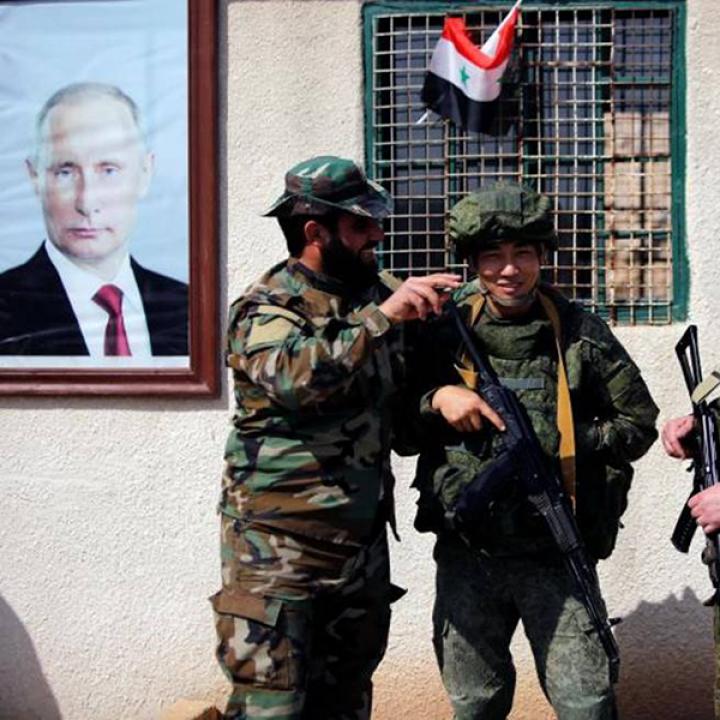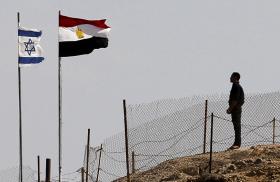
- Policy Analysis
- PolicyWatch 3516
Iran and Russia Are Exploiting America’s Absence in Northeast Syria

By redeploying their military and proxy forces, boosting Assad’s political campaigns, and resorting to various local intimidation tactics, the two countries are increasingly working together on establishing full control in Deir al-Zour.
On July 11 and again two days later, Iranian-backed Shia militias conducted attacks near al-Omar oil field in Deir al-Zour, part of a wider pattern of escalation against the American presence in Syria’s geostrategically crucial eastern border province. Yet such provocations are just one small example of how U.S. adversaries—Russia as well as Iran—are expanding their local influence with the goal of ensuring de facto control over the entire area. Despite the conventional wisdom that Moscow can be pressured into cooperating with the United States in Syria and curbing Tehran’s ambitions there, recent developments in Deir al-Zour paint a different picture.
United Front in the Northeast
Russia and Iran have more reason than ever to maintain their working alliance in Syria. Moscow depends heavily on Iranian activities in Deir al-Zour to maintain Russian influence there; in return, Iran benefits strategically and financially from its relationship with Bashar al-Assad’s primary military backer.
In addition to securing Russian interests and ensuring Assad’s survival, this dynamic has enabled Moscow to play the role of a genuine partner on the world stage while working against the international community’s diplomatic goals at the local level. For instance, it has repeatedly pretended to cooperate with UN negotiations toward a political transition as mandated by Security Council Resolution 2254, but its local activities are wholly focused on working with Iran instead. Similarly, Russia made a show of suppressing Iranian expansion by pushing Shia proxy group Liwa Fatemiyoun out of oil and gas fields near Raqqa this March, yet their forces have since cooperated on operations aimed at exerting wider influence in Deir al-Zour, changing the province’s demographic makeup, and driving out the United States, the global coalition, and the Kurdish-led Syrian Democratic Forces (SDF).
Infiltrating Local Tribes, Stealing Vacant Properties
A substantial part of Tehran’s strategy in Deir al-Zour relies on spreading its brand of Twelver Shia Islam among the area’s predominant tribes. This includes tactics such as infiltrating the largely Sunni Arab social fabric and exploiting dire economic conditions by offering financial assistance to families of militia recruits if they are willing to convert. According to local activists, at least 10,000 Syrians have joined Iranian- and Russian-backed militias in Deir al-Zour in recent years. Combined with the many Shia foreign fighters deployed there, this gives Iran and Russia a total local proxy force of approximately 25,000, mostly concentrated west of the Euphrates River.
Moscow has facilitated another Iranian tactic as well: stealing abandoned private properties so that foreign fighters can use them as cover from airstrikes. As of April, around seventy-five such properties had been seized in Abu Kamal and Mayadin alone. For instance, the militia Liwa Fatemiyoun has reportedly stolen fifteen properties in Mayadin and established at least ten weapons depots in Ayyash village north of the provincial capital. Similarly, the militia Liwa Abu Fadl al-Abbas has hidden large numbers of weapons among archaeological ruins and tunnels near Mayadin to evade airstrikes. Iran is also buying large swaths of land in the area at very low prices, taking advantage of locals desperate for cash.
Another Iranian and Russian tactic is to entice notables and tribal sheikhs with economic promises, including revenue from smuggling weapons and drugs between Syria and Iraq. Since 2017, for example, Sheikh Nawaf al-Bashir and much of his large Baggara tribe have been publicly allied with Iran and the Assad regime. In Deir al-Zour, the sheikh has recruited and financed fighters for Iranian-backed militias such as Liwa al-Baqir. As of mid-June, Russia and the Assad regime have tasked this militia and the umbrella group it belongs to (Usud al-Ashaer) with weakening the local SDF presence. Leaders from other tribes (e.g., the Jabbour, Mushadah, Bukhabour, Muamrah, and Buasi) have likewise submitted to Russian and Iranian orders, accepting financial assistance in return for working against the SDF. Although Moscow and Tehran sometimes compete for influence over these cash-strapped tribal communities, their overall behavior is increasingly shifting toward cooperation.
Campaigning for Assad Behind the Scenes
The Syrian regime’s latest rigged election was facilitated by Russian and Iranian activities in Deir al-Zour. These included pumping funds and manpower into the campaign, creating a false sense of Assad’s legitimacy, and intimidating local figures into compliance.
For example, some personnel collected phone numbers and addresses of residents in Abu Kamal, Mayadin, and other areas and pressured them to vote. Any imams who refused to talk favorably about the election during Friday prayers were arrested. Dignitaries, tribal sheikhs, businessmen, and militia leaders were likewise pressed to assist the scheme. Meanwhile, Ala al-Shuwaish and other local figures linked to Iran’s Islamic Revolutionary Guard Corps (IRGC) sought to attract voters by opening electoral tents that they called khayemat watan (tents for the homeland). To avoid public backlash, personnel were careful not to raise any Russian or Iranian banners in electoral settings.
Providing Military Protection
According to local activists, Russian contractors such as the Wagner Group have increasingly helped Iran safeguard its military presence in Deir al-Zour, both by giving IRGC and militia personnel advance notice of expected airstrikes and by helping them relocate bases. Moreover, since 2017, Russia has reportedly provided Iranian-backed militias with ammunition and funds to carry out campaigns against the SDF and any local opposition forces or protests.
Moscow’s assistance has extended to direct operational involvement as well. On the west side of the Euphrates, Russian warplanes surveil the Badia region daily, taking off from Deir al-Zour Airport to areas south of Raqqa such as Ghanem al-Ali and al-Zamleh. Part of their mission in this tenuously controlled portion of regime territory is to provide protection for IRGC projects, which include maintaining oil and gas fields damaged during the fight against the Islamic State as well as building new prisons and bases. Russia also has a military presence in al-Shola, Kobajeb, and al-Bishri.
For other missions, Russia has relied on the Local Defense Forces, a large militia umbrella group with members nationwide. For instance, one force established by Abu Kamal native Hussam al-Qaterji in 2019 was tasked with securing oil/gas fields and pumping stations (e.g., T2, T4, al-Nishan, al-Taim, al-Kharatah, al-Shola) as well as crossings with SDF territory (e.g., Husseiniyah, Salihiyah). And earlier this year, Moscow fortified its presence in Deir al-Zour by transferring various Russian-influenced militia units there, including the so-called “5th Corps” and the Palestinian group Liwa al-Quds. Together with the Assad regime’s 4th Armored Division and irregular National Defense Forces, the 5th Corps is tasked with conducting raids in the area.
Recommendations
Sporadic U.S. military operations will not be enough to counter this concerted Russian and Iranian bid for control of northeast Syria—nonkinetic assistance is desperately needed as well. As part of a general effort to defend civilians, Washington and its allies should protect and support local activists and citizen journalists who continue to break stories about the activities recounted above. Gaining the trust of Deir al-Zour’s tribal communities and empowering them to resist foreign intimidation is key as well. The U.S. government should fund and facilitate direct humanitarian aid deliveries to these communities, working as closely as possible with the traditional leadership. At the same time, it should vigorously impose sanctions on any Syrian, Iranian, or Russian individuals involved in local human rights abuses.
To be sure, the United States has a full agenda of other regional and global issues to address with Iran and Russia. As it pursues negotiations and seeks agreements on these issues, however, it should be under no illusions that Tehran and Moscow will voluntarily abandon their ambitions to establish complete military and political control in northeast Syria.
Oula Alrifai is a senior fellow in The Washington Institute’s Geduld Program on Arab Politics. Ali Alleile is the founder and CEO of the independent news platform @DeirEzzor24. His work focuses on security and governance dynamics in Syria’s northeast region.



